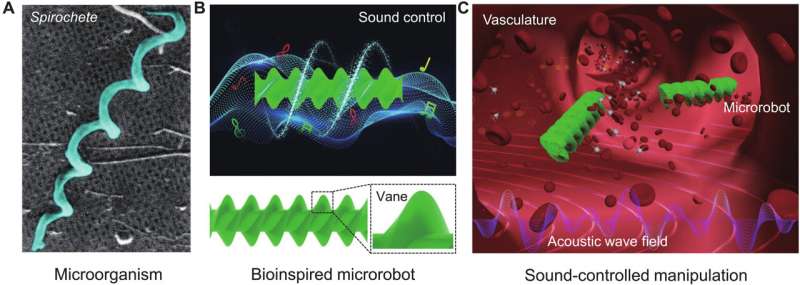September 21, 2023 report
This article has been reviewed according to Science X's editorial process and policies. Editors have highlighted the following attributes while ensuring the content's credibility:
fact-checked
peer-reviewed publication
trusted source
proofread
Using sound waves to propel a microrobot through narrow tubes

A team of robotic and acoustic engineers from the Institute of Robotics and Intelligent Systems, ETH Zurich, and Institut für Theoretische Physik, Center for Soft Nanoscience, Westfälische Wilhelms-Universität Münster, has developed a microrobot that can be propelled through narrow tubes using sound waves. In their paper published in the journal Science Advances the group describes how they designed their robots and how well they worked when tested.
For many years, medical researchers have been looking for ways to introduce drugs into the body in more directed ways. Doing so would allow for sending drugs only to the parts of the body that need medicine, thus preventing many undesired side-effects. Prior efforts have resulted in the development of a variety of technologies, with some of the most promising involving using tiny robots controlled by an external magnet.
While such an approach has shown promise, it still has problems that must be overcome, such as precision control. In this new effort, the research team has instead used sound waves to propel a tiny robot, an approach that could prove more suitable for use in the body.
The idea behind the new robot is to capture the energy in sound waves as a means of propelling a motorless robot. To achieve that, the team 3D printed a bit of non-toxic polymer in the shape of a corkscrew. They then placed their corkscrew inside of a glass tube filed with water (or alcohol). Next, they fired sound waves at the corkscrew. The sound waves, the researchers note, make the molecules in the liquid vibrate, which creates a vortex, and that pushes the robot forward.
The research team found that they could also change the speed at which the robot moved through the tube and its direction by changing features of the sound waves. They also found that by increasing the sound wave frequencies, they could push the robot upwards through a tube tilted at a 45-degree angle.
The researchers next plan to test their robot in tubes made of more flexible material, to more accurately simulate a human blood vessel. They note that they are also working on what they describe as an acoustic helmet, which they believe will give more control over the robot.
More information: Yong Deng et al, An acoustically controlled helical microrobot, Science Advances (2023). DOI: 10.1126/sciadv.adh5260
© 2023 Science X Network


















